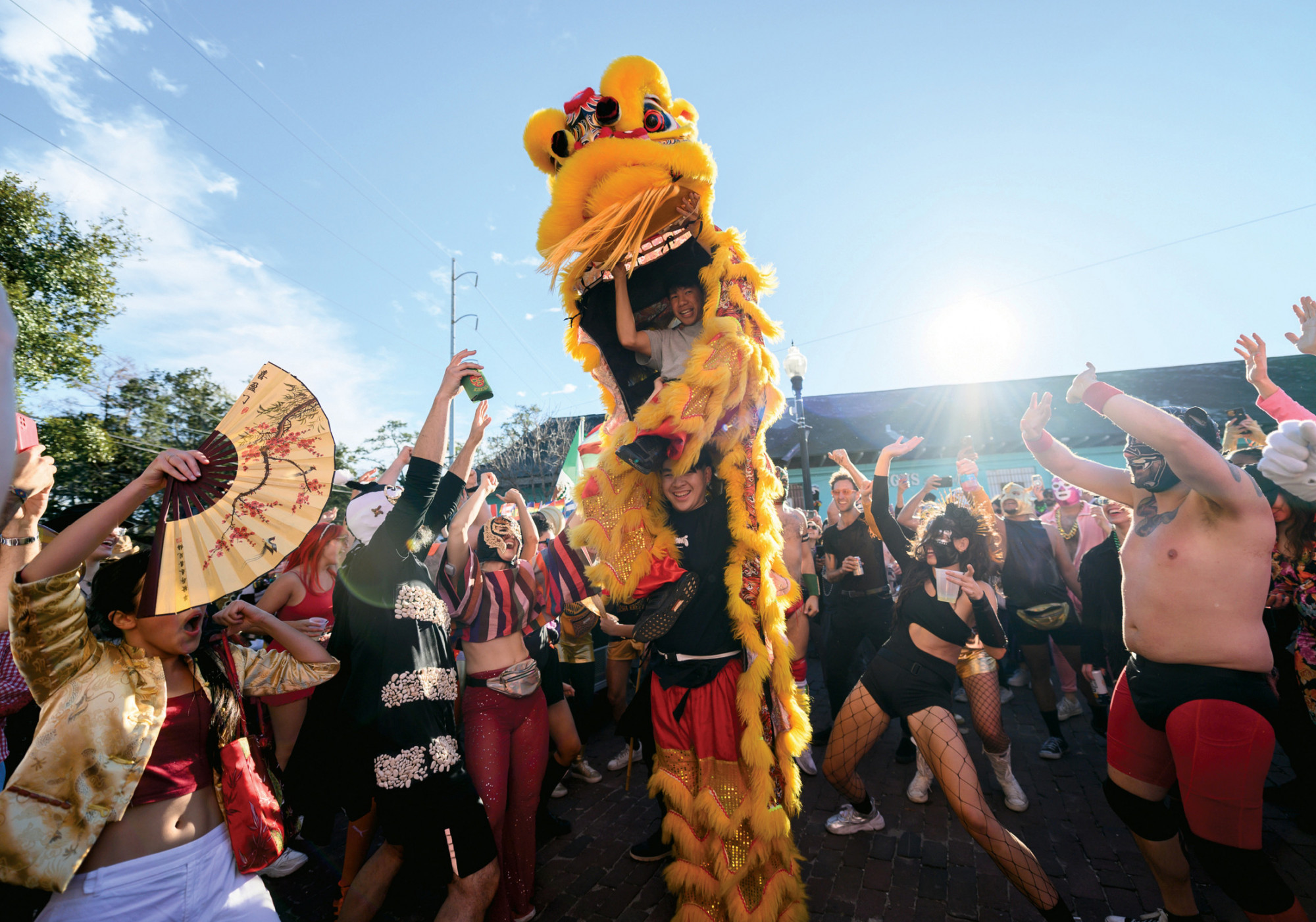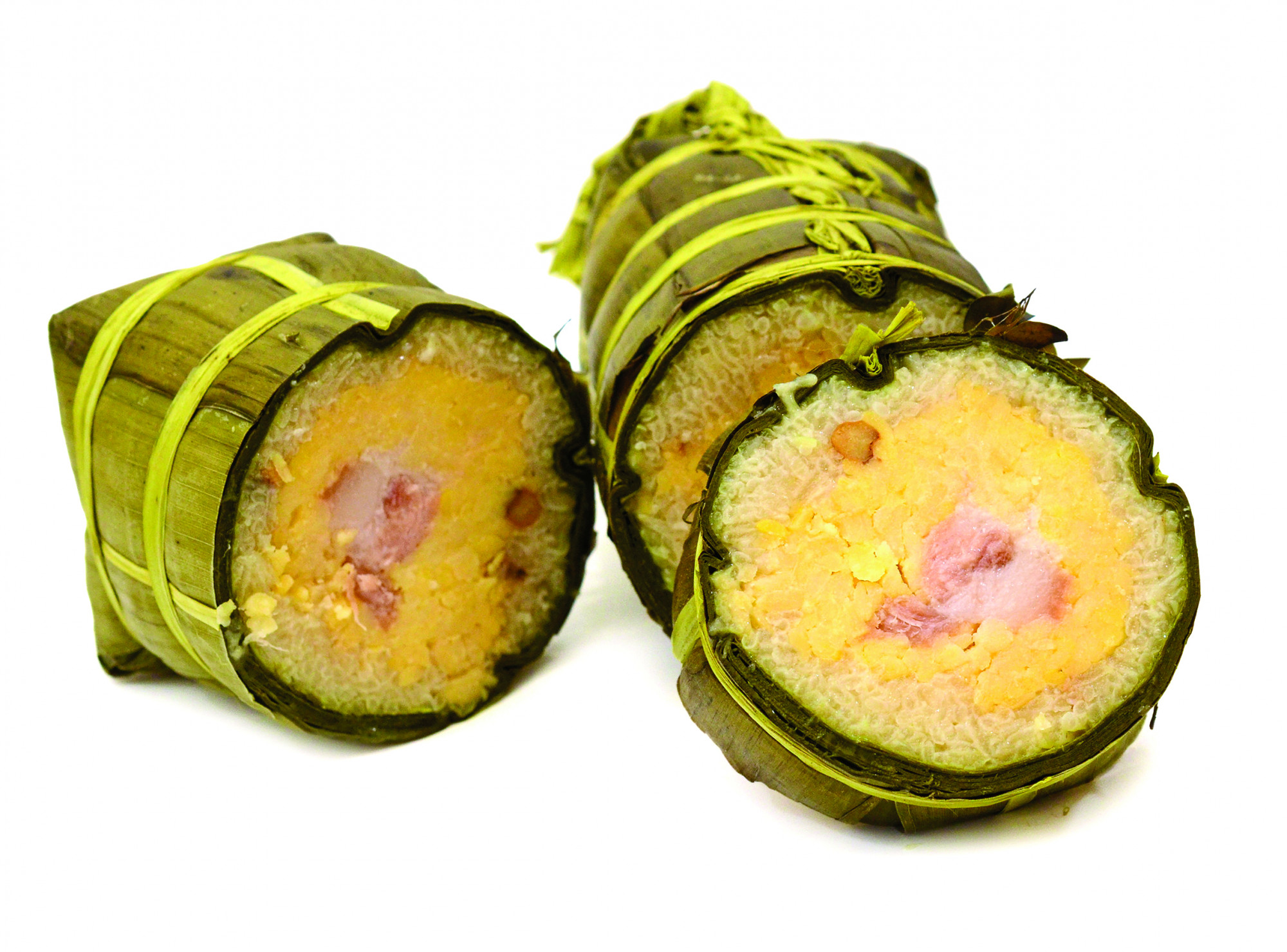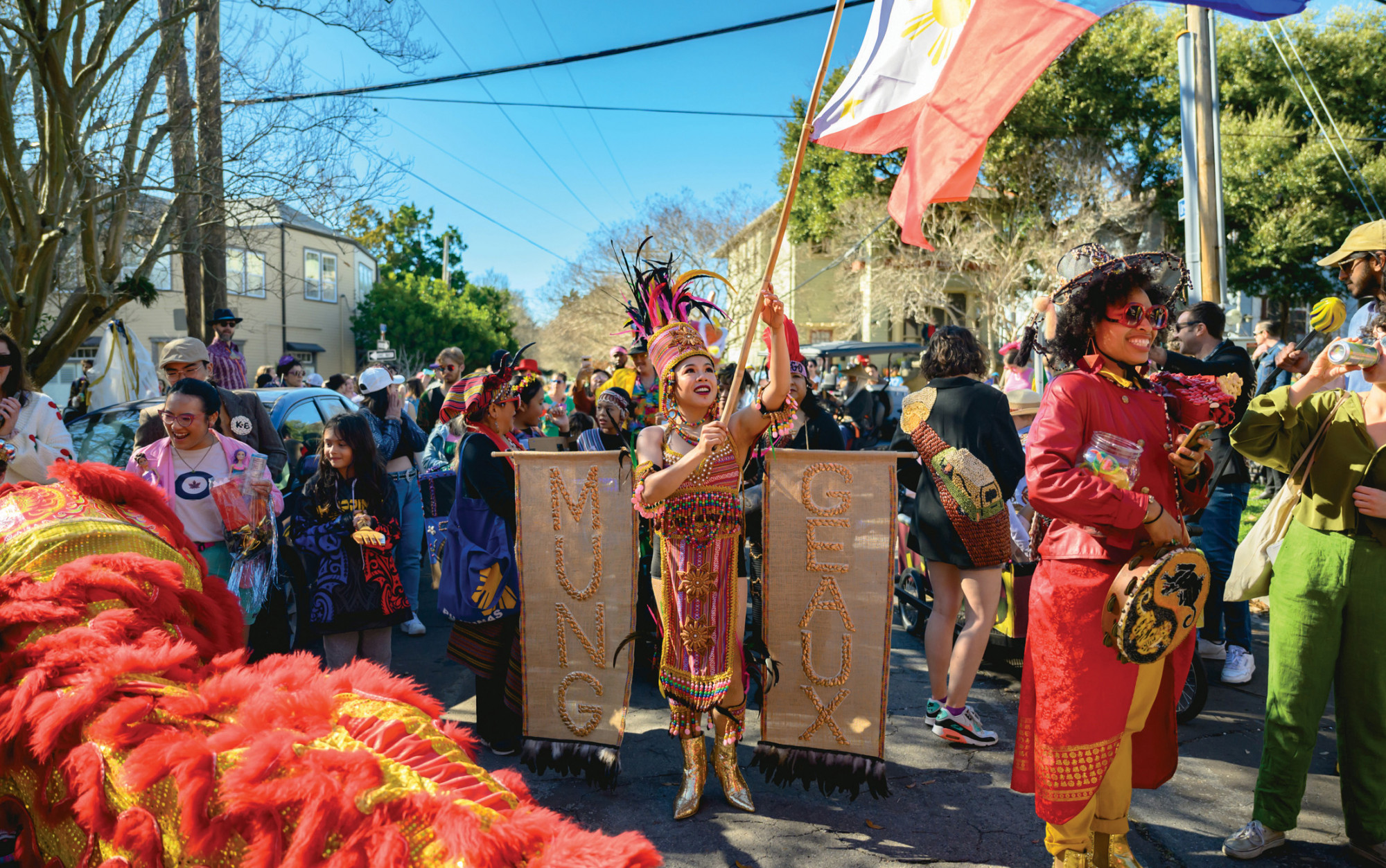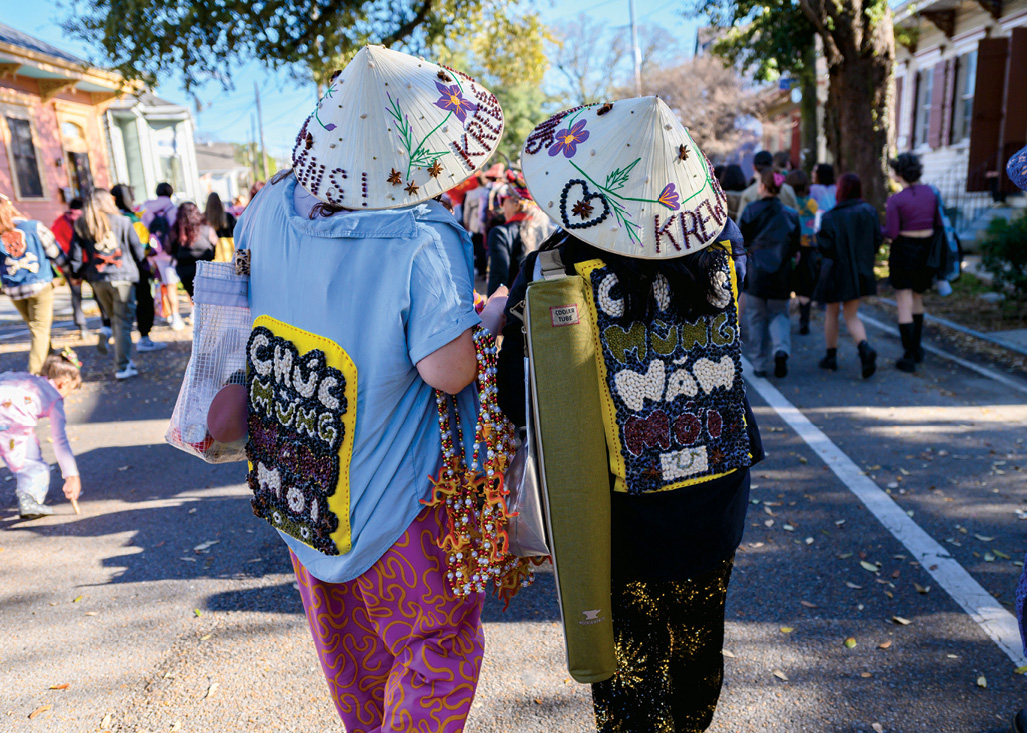
The Woodlawn Lion Dance Team dances with the Lucha Krewe during the Red Beans Parade. Unless otherwise indicated, all photographs are from February 12, 2024, and © Dung “Donkey” Nguyen
In the Streets with the Krewe of Mung Beans
Redefining the spirit of New Orleans
By E. M. Tran
In the dried herbs and spices aisle at Hong Kong Food Market, Melly and I waffled before bags of colorful beans in crinkly plastic packaging. The store was packed, checkout lines extending into the aisles. Noodles, jars of fermented sauces, and shriveled mushrooms threatened to tumble from their crammed shelves in the melee of the store. We parted throngs of people using our shopping cart as a wedge. The stench of fish on the edge of freshness assailed us, but underneath that decay, I could smell the wafting scent of slow-cooking vịt quay. An abundance of prepared foods sat on foam trays wrapped tightly in cellophane: bao filled with minced pork, green pandan jelly cakes, spring rolls, and silky sheets of bánh cuốn.
Metal trays were piled high with bánh tét, a sticky rice roll filled with mung beans and pork belly, wrapped and steamed in banana leaves. These logs of rice were the cause of much anxiety for me every Lunar New Year. Each one had handwritten labels, messily scrawled Vietnamese specifying if it was filled with pork or pink bananas, whether it had additions like dried shrimp or pandan or coconut milk. All of them have mung beans. I have never learned to speak or read Vietnamese, and this fact brings with it shame in any Vietnamese space I enter. Every time I am asked Nói tiếng việt? humiliation wells up inside me and I am reminded of that familiar feeling: the feeling when the other kids at my middle school said, in a biting and fluent Vietnamese tongue, that I was Americanized. All of this crowded inside me as I flapped around the trays of bánh tét every year, trying to translate the labels. Perhaps it was fitting that Melly was there with me for this visit—we had endured much of this ridicule and cultural guilt jointly, having known each other since preschool and growing up together through the worst parts of adolescence.
That day we were shopping for that singular ingredient, mung beans. In jellied desserts piled high in clear glasses with crushed ice and coconut milk, mung beans were chalky blobs of yellow mash. My mother ordered these treats at our family’s favorite restaurant, an innocent glee as she jammed a spoon into her glass to muddy its colorful layers. Not knowing what mung beans looked like uncooked, I squatted low to read the labels. We had already filled our cart with several other types of beans.
“Here they are,” Melly said, grasping a package full of tiny green pellets. They looked like miniature olives, something elegant in the shape. A thin black line punctuated by a white dot along the face of each one.
“Have you ever made it before?” a man in the aisle asked. He, too, was overwhelmed by the selection of dried beans. He clutched several packages, and his cart was full of ingredients: produce in thin plastic bags, jasmine rice, pork belly. “It’s my first time making bánh tét,” he said, shrugging with an air of commiseration.
Lunar New Year, the year of the dragon, happened to coincide with Mardi Gras last year. While the two holidays were often near each other, each shifting a few days or weeks from year to year, they didn’t usually overlap. Most shoppers were there to buy New Year’s staples. It was why the market was so crowded. For Tết, people cleaned their houses and cooked feasts, family and other visitors traipsing in and out. They were buying things to make bitter melon soup, thịt kho, egg rolls—and perhaps like this man, bánh tét. (My mother always said it took too much effort. Why make them when you can buy them?) But Melly and I weren’t buying mung beans to cook. We would be gluing them, one by one, onto clothing we would wear for Mardi Gras.
After receiving a last-call email about membership, Melly and I made a snap decision to join the Krewe of Mung Beans, a Mardi Gras–walking subgroup of the more well-known Krewe of Red Beans. Tourists may be familiar with Mardi Gras krewes like Rex, Endymion, or Muses, these collections of elaborately decorated rolling floats full of masked people. But the walking krewes are smaller, neighborhood affairs, often featuring a motley collection of locals in homemade costumes tossing out handmade throws and single strands of beads, carrying only what they can haul on a long parade through the city. People who live along the route stand in the street or on porches, not to get free stuff but rather to witness and take part in the spirit of Mardi Gras, which, at its root, is about community, poking fun at the status quo, and an embrace of queerness. But Mardi Gras is also a contradiction, both a celebration of difference and a salute to the deep-rooted traditions of a city steeped in troubled history. Spend any time trying to get into an exclusive krewe, which is so much about who you know and how long you’ve been here—which in turn can be about how old your money is—and you will understand. In the national, and even local, imagination, New Orleans is a static place, defined by the architecture of its French Quarter, the food of its Creole traditions, and the mystery of its surrounding swamps. It is a place that cares a lot about defining, in inflexible terms, what it means to be from New Orleans. So, yes, Mardi Gras is about community. But it is also about exclusion: who is a part of New Orleans, and who isn’t.
After Hurricane Katrina, I lived with my older sister in Los Angeles during my junior year of high school. I begged my father to let me come home. I had never appreciated New Orleans until I left it, forced from its humid embrace into the epicenter of mass-produced mainstream American culture, everything shiny and new. It was a shock. New Orleans was a place fraying at the edges, literally crumbling, its houses full of mold and its people as strange and weathered as the city in which they rooted themselves. In Los Angeles, I mourned my life in New Orleans, which I had already turned into some collapsed version of itself, a string of familiar images. Historic buildings, second lines, smoke-filled jazz bars, Mardi Gras beads, and gumbo. I had fallen victim to the outsider’s clichés of my own home. My Californian classmates asked me why I didn’t have a Southern accent.
When I finally persuaded my parents to let me come back, New Orleans was only a year into recovery, and on my daily drive to school I passed gutted buildings, holes axed through roofs. Electricity was unreliable, and FEMA trailers were as much a part of the landscape as the oak trees. Some might wonder why anyone would’ve wanted to come back to that. Consider this: Just six months after the hurricane, while I was trapped in an arid city full of freeways, New Orleans had its Mardi Gras. In the lightless streets, people put on costumes and drank with their families. High schoolers took their instruments out and marched. I felt such jealousy from across the country, imagining the romance of that moment. Not far beneath its desolation, the spirit of the city was persistent.
Which is why, newly returned, I felt a desperate anticipation for Mardi Gras, as if I needed some ceremony to confirm I belonged to this place. With my friends and a thousand strangers, a year and a half after parts of our city had been submerged in floodwaters, I danced on the streets of St. Charles, a backpack full of wine coolers and a liter of Big Shot pineapple soda mixed with vodka that tasted like rubbing alcohol. Glowing floats dragged by tractors rumbled one by one before us, and when the bleating sound of police sirens finally followed, the streets strewn with plastic bags and beads, a classmate asked if I wanted to come over to her house for an afterparty.
We walked a few blocks off the parade route to her house, which was modest and unremarkable in the context of the neighborhood. But it was a classic New Orleans home: a pale pink shotgun with elaborately scrolled corbels and tall windows that provided passage onto the front porch. We walked through an iron gate and across a bricked patio overgrown with elephant leaves and palms.
My classmate’s mother, clad in a feather boa and gripping a drink, ushered us in. She hugged me as if we knew each other and asked if I needed something to eat, motioning nonchalantly to the options. On the stove, a pot had been simmering all day in anticipation of post-parade hunger. The small breakfast table was covered in a variety of king cakes. Then she was gone as quickly as she had appeared, disappearing into the crowd of people in her living room to dance. Many of my classmates were there, in the preppy uniform of wealthy white New Orleanians, a green, gold, and purple Perlis polo, an embroidered crawfish on the breast. They drank from red Solo cups as plastic beads jangled around their necks. Sequin- and feather-clad guests were everywhere, helping themselves to food and drink, shouting merrily across the room. Everyone seemed to know each other.
I remember realizing something, in that kitchen of a high school classmate when I was seventeen: I would never be a part of this New Orleans. My mother could never be this mother, carefree and drunk and indistinguishable from Mardi Gras itself. My home could never be this home, not as historic or charming or colorful, embedded in an iconic neighborhood a short walk from the banks of the Mississippi River. Even if I bought a historic home one day, I would be an interloper to its history. There were no generations of Trans in New Orleans, no ancestor who worked in sugar or coffee, no grandmother with a red beans and rice recipe to pass on. My parents’ Vietnamese-tinged English made us foreign, as far from a New Orleans accent as one could be. My family, violently removed from their homeland after the fall of Saigon, had no roots here. My West Coast fantasies of home had been just that. Isn’t that the generational trauma of displacement? You belong in neither place. The fact that I was born and raised in New Orleans has never felt good enough, has never qualified me enough to belong. Where are you from? people ask, and they are never asking about New Orleans.
Mung beans can be found in the Lunar New Year sticky rice cake, bánh tét, but they are also found in cakes and puddings, in dumplings and desserts, in medical remedies and health tinctures. When I asked my mother about the history of mung beans—if there were any interesting folktales or cultural myths around them—she looked at me like I was stupid. “It’s just what we had available,” she said.
I wish I could say the mung bean has an agreed-upon symbolic meaning, that it signifies fertility or stands in for some cultural trait, but the truth is that the mung bean is so prevalent across Southeast Asian cuisine because it thrives in the hot climate and soil of the region, because it is a resilient crop, because it can be eaten raw, dried, sprouted, or ground into a flour. It is a cheap and accessible source of protein that can be used in savory or sweet dishes.

Photograph © Phong/AdobeStock
There is a folktale about bánh chưng, bánh tét’s square northern counterpart, which can be found in Lĩnh Nam chích quái, one of the earliest collections of Vietnamese folklore dating back to the fourteenth century. The story “Chưng bính truyện” tells of a king who needs to pick an heir among his many sons. He hosts a cooking competition to choose one. Nineteen of the sons go far and wide to find some delicious delicacy, but one of them, Lang Lieu, is too poor and cannot travel. A deity meets him in his dreams and advises him to use sticky rice to make a leaf-wrapped cake, as no exotic or foreign food could compare to the nourishment of homegrown rice. Lang Lieu, of course, is named heir.
While fictional, this story reinforces what my mother seemed to flippantly suggest: We make and eat bánh tét every year because of the very simple fact that we had the ingredients. Making bánh tét is also a way to preserve food, so that people could stretch the length of time their pork might last. But the tale also shows us the ways available foods become tied to national or cultural identities. What could be a better delicacy with which to celebrate the new year than rice and mung beans, those reliable and sustaining things? And in turn, what could be more Vietnamese?
Melly and I spent many hours at my kitchen table, painstakingly hot-gluing a variety of dried beans onto shirts. Our fingers were scorched from the efforts, but when we stood back, our elaborate bean mosaics read CHÚC MừNG NĂM MớI. We glued beans and star anise onto rice paddy hats and debated whether our costumes were good enough. The Krewe of Red Beans was known for their bean-decorated costumes, and its sub-krewes were required to wear this uniform. If the Krewe of Mung Beans wanted to be a part of Mardi Gras, this was one of its requirements. There had been several “beaning” sessions at the Krewe of Red Beans headquarters, Beanlandia, where all the sub-krewes had an opportunity to meet each other, socialize, and share knowledge about how to bean. Because beaning, it turned out, was a difficult craft, especially at the scale krewe members were doing it, and the information was mostly passed on communally, through these gatherings. Intricately adorned suits, heavy over-the-head masks, and all manner of beaned props took months to make. Some people started planning next year’s costume on Ash Wednesday, the day after Mardi Gras.
Krewe members advised that sketching our designs on parchment paper was key, hot glue was the preferred adhesive, and a clear slick of Mod Podge on top would keep our beans in place during a day of marching. We were encouraged to come to the beaning parties. While Melly and I never outright discussed it, there was a silent agreement between us that we wouldn’t go—instead we’d do this just the two of us, alone in one of our homes. Even if we didn’t know what we were doing, even if our costumes turned out horribly, even if we burned the tips of all ten digits, we wouldn’t go.
I didn’t go, because I was afraid. Maybe I wasn’t Vietnamese enough to be in the Krewe of Mung Beans. Maybe Mung Beans wasn’t New Orleanian enough to be a part of the Krewe of Red Beans and I was just desperate, again, to claim some small ownership of Mardi Gras. If I delayed meeting my fellow krewe members, I could live in my fantasy, the one where I knew how to turn beans into a work of wearable art, could speak in my mother’s tongue, had a generations-old red beans recipe I made every Monday, could correctly identify and purchase the bánh tét I wanted. Being good at beaning, being in the right Mardi Gras krewe, being able to shop at the Asian grocery store without feeling incompetent—writing it out sounds ridiculous because all of it seems insignificant. But at the root of these desires is the fantasy that I could be both rather than neither, all rather than none.

Southeast Asian representation in the Krewe of Mung Beans.
For the next carnival season, in 2025, the Krewe suggested that we were free to operate independently. To put it another way, we’d been asked to leave. The desire to part ways was mutual—somewhat tinged with acrimony and occurring a mere three months before Mardi Gras, the tipping point reached at the season’s first Mung Beans meeting in November, where differences between the Red Beans founder and Mung Beans krewe members became starkly evident. While the reasons are somewhat opaque, they have to do with money (as almost everything does) and a misalignment of values. The Krewe of Mung Beans, as many of its members have explicitly stated to me, is about, first and foremost, supporting and elevating Asian voices, experiences, and communities in New Orleans. Somehow, we were at odds with Red Beans, though I suspect our severance has a lot to do with a general disagreement of personalities. In a Mung Beans Krewe WhatsApp group, people who attended the November meeting expressed disappointment at the way the conversation, which was supposed to be an exciting planning session for the coming parade season, had gone. They explained that when the Red Beans founder joined the discussion, he fixated on the group’s financial obligations. “This was my first meeting of the season and it left a bad feeling,” one member, Thuy, said. “We started as an existing community before becoming Mung Beans,” another member, Amy, said as talk swirled about leaving Red Beans.
The next day, we were given the option to part ways. After a conversation between one of our members and the Red Beans founder, it was determined that our primary goal—building social opportunities for the New Orleans Asian community—did not align with being a part of Beanlandia. We were then tasked with choosing a new name to cut off any association we have to beans, a development I find amusing. In search of a new name, a new way to parade in time for Mardi Gras, we are resisting becoming neither and none. Others can interpret this uncoupling however they please, but for me, it comes back to this question: Who is allowed to participate in the identity-making of New Orleans?
The day of the 2024 parade was the third day of Lunar New Year, and also Lundi Gras. Monday, of course, the day New Orleanians traditionally have red beans and rice. A suitable day for the Krewe of Red Beans and its sub-krewes to march. A few days earlier my mother had made bánh tét for the first time and proudly sent them home with us. “We never have to buy pre-made from Hong Kong supermarket again. Too expensive,” she’d said. I ate slices of bánh tét pan-fried in coconut oil for breakfast. The mung bean center soaked up nước chấm. I put a pot of red beans in a slow cooker so that, after my long day marching, I would have something to eat. Beans and rice for both meals. Were they really so different?
The Mung Beans were congregating at one of the krewe member’s houses for camaraderie, food, and a short photoshoot before leaving together for the parade. We have to go, right? Melly and I asked each other, reluctantly. We were full of nervous energy as my husband dropped us off a block away. We wanted to walk up to the house, to have time to gather ourselves. My body was tense, as if it were physically bracing against judgment sure to come when we arrived. Suddenly, I was twelve years old again, the other Vietnamese kids making fun of my awkward jog around the kickball diamond using a language I should’ve been able to understand.
When we got there, an arts and crafts Bayou St. John neighborhood home, people were spilling out of the open door, on the front porch chatting, on the steps fixing costumes. We were ushered in, fussed over, and offered food. On the kitchen table, a pyramid of banh mi; on the stove, a pot of simmering gumbo. There were members wearing áo dài, but just like mung beans themselves, the krewe was more than one cultural identity: Members wore qi pao and barongs and terno sleeve dresses, shoulders and backs adorned in ornate dragon designs made entirely of beans. Several people asked to look at our costumes, and Melly and I spread our arms to better display our bean mosaics, for the first time feeling proud rather than self-conscious. There were exchanges of admiration happening all around the room. A backdrop had been set up for portraits; one of our krewe was a photographer and would later photoshop us together in a fake poster for Paris by Night, a direct-to-VHS variety show and a cultural artifact specific to Vietnamese diasporic experience. The posters were known for being gaudy and chaotic, featuring a few dozen performers behind kitschy fonts. Though I didn’t know most of the other krewe members yet, I didn’t feel that I did not belong. In fact, there was that rare feeling—the comfort of a shared inside joke as we waited to get our portraits taken.

E. M. Tran (right) and her friend Melly wear their designs made of mung beans.
We migrated as a group to Cabrini Bridge, a bright-blue pedestrian bridge over the bayou where our krewe would embark on our parade route. The area was buzzing with energy and full of people from other krewes leaving from the same place. As parade goers lined up along the sidewalk and the edge of the bayou, there was a sense of awkwardness. At first, no music—just the rush of wind and the sound of our own voices. How many miles of this did we have to endure? Then, the hollow thump of a drum and the repeated clanging of cymbals.
Behind us, Vietnamese lion dancers jumped and twisted to the rhythm of the drum. The energy of the crowd seemed to bloom, spectators full of a giddy, childlike awe as the dancers wove among the krewe. Each feathered lion had two young men beneath it, never ceasing movement as they advanced along the route. One krewe member, Thi, wore a breastplate, each bean a link in her impenetrable armor. She was channeling Lady Trieu, a famous, almost mythic woman warrior in Vietnam who led an uprising against invaders, riding into battle on an elephant. Thi ran around the dancers, lifting her staff like a lion tamer. Someone pushed the large wooden drum on wheels as another krewe member relentlessly beat the animal-skin drumhead.
We walked through the middle of New Orleans, handing out strands of dragon beads and paper accordion fans. The air was cold in the shade and balmy in the sun. It was uncharacteristically windy that day, the breeze whistling through my rice paddy hat. Strangers thanked us and offered drinks as we handed them red New Year’s envelopes. I saw people I knew on the route, their recognition of me as I paraded through the street like a confirmation: I really was from here, after all. At an intersection, the dancers stopped to perform under the oaks. The afternoon sun was lowering, beams of light filtering through the branches. I could see dust and debris floating in the light. The drum beat in my bones and there was a tight, warm feeling in my chest. Lunar New Year and Mardi Gras had melded together and made this. I looked around at the people I was with—full of joy and carnival fervor, and they looked like me.
After our departure from Red Beans, we scrambled to find a way forward. A panic seized us. What if we didn’t walk at all this carnival season? What would we even call ourselves? Mung Beans, its ubiquity as a food staple across Asia, had been inclusive. It had highlighted the importance of food as a way to preserve and transport culture despite displacement. To lose the name was difficult, but as one member pointed out, to shed our previous identity was appropriate for 2025: the Year of the Snake.
We have a new name now—Krewe of PhantAsia—one that we voted on together. Phantasia encompasses visual extravagance, ghostly apparitions, and fantasy. The name, besides housing the word Asia, celebrates spectacle, entwining us with the theatrical and artistic indulgence of Mardi Gras. And, another krewe, Krewe Bohème, invited us to join their parade through the French Quarter on Valentine’s Day.
Regardless of my Mardi Gras krewe, this Lunar New Year I am resolved to make bánh tét for the first time, using what was left of the mung beans I’d bought last year to decorate my carnival clothes. Perhaps I will bake my own king cake and fold a mung bean into the dough in lieu of a plastic baby. I will certainly make a pot of gumbo, seasoned with a splash of fish sauce and served with a scoop of steaming jasmine rice, so that I have something to eat after cavorting in the streets of my city. And Vietnamese lion dancers will prance on the bricked thoroughfares of the Vieux Carré for carnival, a scene of pure phantasia plucked from my wildest dreams.
This story was published in the print edition as “Lundi Gras Lion Dance.” Buy the issue this article appears in here.




